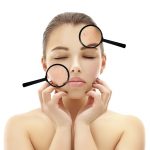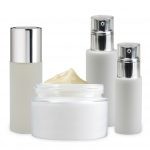How to Deal With Red, Itchy and Irritated Skin
Red, burning and rawness of the skin, are the body’s ways of telling us that there is a problem. If your s kin becomes damaged due to the daily wear and tear, weather abuse or even an allergen, our immune system sends blood rushing to the area with oxygen and immune cells to repair the damage.
kin becomes damaged due to the daily wear and tear, weather abuse or even an allergen, our immune system sends blood rushing to the area with oxygen and immune cells to repair the damage.
Here are a list of symptoms, what they might mean and some easy ways to treat them;
Symptoms: Redness, scaling and flaky skin around your eyebrows, nose and behind your ears as well as your scalp.
Possible Diagnosis: You may be suffering with Dandruff (Seborrheic Dermatitis.) This means that your skin cells have a renewal rate which is too fast. As this process is happening too quickly, the cells tend to become sticky and do not drop off as easily as they should.
Remedy:
Using shampoos which are ‘dandruff fighting’ can be a great if you would like to reduce the dandruff o n your head, however what can you use on your face? Well, using a mild solution of salicylic acid to cleanse the skin, can be a good way to loosen up the sticky skin cells. Once washing your face with this solution, always follow up with a non-greasy, non-pore blocking moisturiser. Another way to help reduce the inflammation around your nose and behind your ears is by applying a very low percentage hydrocortisone cream. You can get hydrocortisone cream over the counter. Apply this steroid cream once before you go to sleep at night and once when you wake up. If your dandruff still hasn’t cleared up, then using an anti-fungal treatment, which you can buy over the counter, is the next step. Using an anti-fungal twice a day for 5 days can really help to eliminate your dandruff. If however, nothing seems to work, contact your doctor or dermatologist.
n your head, however what can you use on your face? Well, using a mild solution of salicylic acid to cleanse the skin, can be a good way to loosen up the sticky skin cells. Once washing your face with this solution, always follow up with a non-greasy, non-pore blocking moisturiser. Another way to help reduce the inflammation around your nose and behind your ears is by applying a very low percentage hydrocortisone cream. You can get hydrocortisone cream over the counter. Apply this steroid cream once before you go to sleep at night and once when you wake up. If your dandruff still hasn’t cleared up, then using an anti-fungal treatment, which you can buy over the counter, is the next step. Using an anti-fungal twice a day for 5 days can really help to eliminate your dandruff. If however, nothing seems to work, contact your doctor or dermatologist.
Symptoms: Rawness, dry and scaly skin.
Possible Diagnosis: Sensitive skin, made worse by environmental factors and everyday stresses.
Remedy: Sensitive skin can be caused by numerous factors these can include; excess sun, over-washing, allergic reactions, sensitivity to products in your makeup or moisturisers and stress. A way to help reduce sensitivity, is by applying a moisturiser that contains antioxidants, ceramides, green-tea or liquorice extracts. These ingredients all help to naturally reduce inflammation and promote healing. Once you have applied your moisturiser, use a small amount of over-the-counter hydrocortisone cream on the irritated parts, twice a day for up to two weeks. Hydrocortisone cream is an amazing way to reduce the redness. If you are using anti-aging products, these can affect the sensitivity of your skin. Anti-aging products that contain retinoids can be the cause of irritated skin.
allergic reactions, sensitivity to products in your makeup or moisturisers and stress. A way to help reduce sensitivity, is by applying a moisturiser that contains antioxidants, ceramides, green-tea or liquorice extracts. These ingredients all help to naturally reduce inflammation and promote healing. Once you have applied your moisturiser, use a small amount of over-the-counter hydrocortisone cream on the irritated parts, twice a day for up to two weeks. Hydrocortisone cream is an amazing way to reduce the redness. If you are using anti-aging products, these can affect the sensitivity of your skin. Anti-aging products that contain retinoids can be the cause of irritated skin.
If you have no improvement, then consult your doctor or dermatologist as they will be able to prescribe topical lotions to help you get rid of your sensitive skin.
Symptoms: Rash, blistered skin, irritation or pink blotches.
Possible Diagnosis: Contact dermatitis. Contact dermatitis usually forms when you come into contact wi th a substance that you are allergic to. Substances such as; perfume in your makeup, parabens, nickel in your costume jewellery, makeup which contains metallic properties and even formaldehyde which can be found in certain nail polishes and lipsticks.
th a substance that you are allergic to. Substances such as; perfume in your makeup, parabens, nickel in your costume jewellery, makeup which contains metallic properties and even formaldehyde which can be found in certain nail polishes and lipsticks.
Remedy: Prevention is definitely the best way to go here. If you always have a reaction when applying a certain perfume or lipstick, ensure that you check the ingredients in order to know what to stir clear of. In fact, a good way to do this is by writing a diary of what makeup or product that you are putting on and when. If you find that there is a certain product that gives you these flare ups, then you will know and can avoid that particular product. If your using a new product and want to know if it is going to cause contact dermatitis, then conducting a ‘skin-patch test’ is a great way to determine if you are going to have a reaction or not.
If however it is too late and you are experiencing a flare up, then there are a number of ways to help you get y our skin back to its original glory. Begin by applying a cold compress of milk to the affected area. Dairy contains many anti-inflammatory properties within the dairy fats, which should help to reduce irritation and inflammation. If the swelling is relieved, but you are still left with an annoying rash, then using a very low percentage hydrocortisone should take away the residual rash.
our skin back to its original glory. Begin by applying a cold compress of milk to the affected area. Dairy contains many anti-inflammatory properties within the dairy fats, which should help to reduce irritation and inflammation. If the swelling is relieved, but you are still left with an annoying rash, then using a very low percentage hydrocortisone should take away the residual rash.
If your reaction is severe, and you are left with open blisters or sores, then you will most likely need a topical antibiotic, which can prescribed by your doctor or health care professional. Blisters and irritated skin can be quite itchy, if this is the case, then taking an oral anti-histamine can be the answer and help reduce the irritation.

